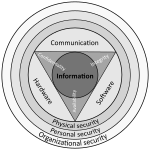The accessibility of this article is in question. Relevant discussion may be found on the talk page. (20161006) |
In computer security, a threat is a potential negative action or event facilitated by a vulnerability that results in an unwanted impact to a computer system or application.
Contents
- Phenomenology
- Threats classification
- Threats Trends
- Common Threats
- Threat classification
- Associated terms
- Threat agents or actors
- Threat source
- Threat communities
- Threat action
- Threat analysis
- Threat Modeling
- Threat Intelligence
- Threat consequence
- Threat landscape or environment
- Threat management
- Cyber threat management
- Threat hunting
- Threat Mitigation
- See also
- References
- External links
A threat can be either a negative "intentional" event (i.e. hacking: an individual cracker or a criminal organization) or an "accidental" negative event (e.g. the possibility of a computer malfunctioning, or the possibility of a natural disaster event such as an earthquake, a fire, or a tornado) or otherwise a circumstance, capability, action, or event. [1]
This is differentiated from a threat actor who is an individual or group that can perform the threat action, such as exploiting a vulnerability to actualise a negative impact.
A more comprehensive definition, tied to an Information assurance point of view, can be found in "Federal Information Processing Standards (FIPS) 200, Minimum Security Requirements for Federal Information and Information Systems" by NIST of United States of America [2]
- Any circumstance or event with the potential to adversely impact organizational operations (including mission, functions, image, or reputation), organizational assets, or individuals through an information system via unauthorized access, destruction, disclosure, modification of information, and/or denial of service. Also, the potential for a threat-source to successfully exploit a particular information system vulnerability.
National Information Assurance Glossary defines threat as:
- Any circumstance or event with the potential to adversely impact an IS through unauthorized access, destruction, disclosure, modification of data, and/or denial of service.
ENISA gives a similar definition: [3]
- Any circumstance or event with the potential to adversely impact an asset [G.3] through unauthorized access, destruction, disclosure, modification of data, and/or denial of service.
The Open Group defines threat as: [4]
- Anything that is capable of acting in a manner resulting in harm to an asset and/or organization; for example, acts of God (weather, geological events, etc.); malicious actors; errors; failures.
Factor analysis of information risk defines threat as: [5]
- threats are anything (e.g., object, substance, human, etc.) that are capable of acting against an asset in a manner that can result in harm. A tornado is a threat, as is a flood, as is a hacker. The key consideration is that threats apply the force (water, wind, exploit code, etc.) against an asset that can cause a loss event to occur.
National Information Assurance Training and Education Center gives a more articulated definition of threat: [6] [7]
- The means through which the ability or intent of a threat agent to adversely affect an automated system, facility, or operation can be manifest. Categorize and classify threats as follows: Categories Classes Human Intentional Unintentional Environmental Natural Fabricated 2. Any circumstance or event with the potential to cause harm to a system in the form of destruction, disclosure, modification or data, and/or denial of service. 3. Any circumstance or event with the potential to cause harm to the ADP system or activity in the form of destruction, disclosure, and modification of data, or denial of service. A threat is a potential for harm. The presence of a threat does not mean that it will necessarily cause actual harm. Threats exist because of the very existence of the system or activity and not because of any specific weakness. For example, the threat of fire exists at all facilities regardless of the amount of fire protection available. 4. Types of computer systems related adverse events (i.e., perils) that may result in losses. Examples are flooding, sabotage and fraud. 5. An assertion primarily concerning entities of the external environment (agents); we say that an agent (or class of agents) poses a threat to one or more assets; we write: T(e;i) where: e is an external entity; i is an internal entity or an empty set. 6. An undesirable occurrence that might be anticipated but is not the result of a conscious act or decision. In threat analysis, a threat is defined as an ordered pair, <peril; asset category>, suggesting the nature of these occurrences but not the details (details are specific to events). 7. The potential violation of security. 8. A set of properties of a specific external entity (which may be either an individual or class of entities) that, in union with a set of properties of a specific internal entity, implies a risk (according to a body of knowledge).




